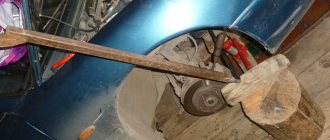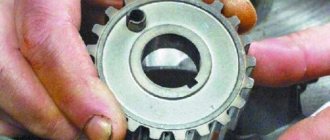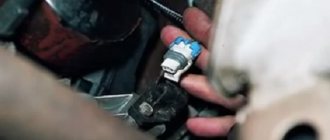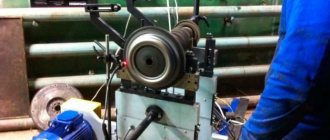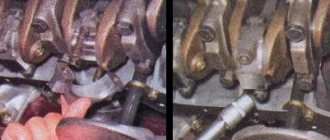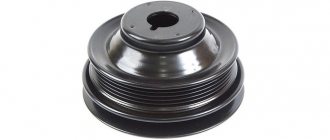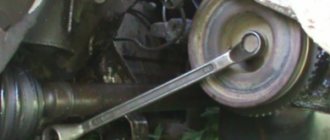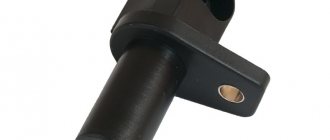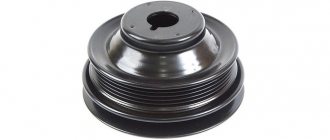Every second car enthusiast, trying to repair his favorite four-wheeled friend with his own hands, was faced with the problem of how to remove the crankshaft pulley. After reading the instructions in the maintenance and repair manual, the procedure does not seem complicated at first glance, but the first time you try to unscrew the ill-fated bolt, it turns out that this is not so easy to do. It is not entirely clear how to secure the crankshaft so that it does not rotate. Another problem is where is the best place to get the coveted bolt. Removing the crankshaft pulley is very difficult due to the tightness. There is a high probability of damaging many parts of the engine compartment or body paint.
The problem is that the bolt (or nut, depending on the model) of the crankshaft pulley is tightened with great force during installation. This is done to prevent this from happening spontaneously, since if unscrewed, serious damage and expensive repairs cannot be avoided. The tightening ratio gradually increases as the engine runs and is aggravated by galling, coking and corrosion.
Actually, the entire disassembly process can take 10-15 minutes, but you need to know and use a few tricks. Some engine models use a bolt or nut to secure the pulley. Each option should be considered.
How to unscrew the crankshaft pulley nut?
The nut at the end of the crankshaft holding the pulley is a sign of the engine of a classic rear-wheel drive car like VAZ from model 2101 to 2107, Niva and the like. This nut is also called a "ratchet" because it may have tabs on it for a "corner starter".
It is better to do the work in the inspection pit. The crankshaft must be secured by placing the transmission in 4th gear and applying the parking brake. It’s worth stocking up on this product in advance:
- 36 (or 38) socket or socket wrench;
- lever extension in the form of a piece of pipe.
While under the car, try to unscrew the nut with a wrench with a long enough lever. If the attempt is unsuccessful, move the gearbox to neutral and do the following:
- candlesticks are removed;
- being in the pit, the key and extension are installed so that the end rests against the floor or spar in the direction of shaft rotation;
- When you turn the key in the ignition switch, a short pulse is given.
As a rule, the nut breaks on the first or second try and is then unscrewed with a regular wrench. Don't forget to loosen and remove the alternator belt.
How to unscrew the crankshaft pulley bolt?
The pulley bolt has priority on front-wheel drive vehicles when the block is perpendicular to the vehicle axis. In this case, you will have to tinker more, since it is more difficult to get closer to the bolt. To work you should prepare:
- Jack;
- "Tragus" (stump);
- bolt-sized socket socket with extension and lever;
- car tool kit.
In search of an answer to the question of how to remove the crankshaft pulley, many car enthusiasts begin to look for an opportunity to do this without prior preparation. By definition, such attempts cannot be successful.
To properly remove the pulley, you need to perform the following manipulations:
- the right front part of the car is raised and the wheel is removed;
- the machine is installed on a “tragus”;
- From the top side of the hood, all parts that impede access are removed: the air filter and the engine dust cover;
- The generator belt is removed;
- to fix the crankshaft on the clutch block, a plug is opened, and a clip is inserted into the resulting window to fix the flywheel teeth;
- under the wheel arch, a head with an extension and a lever is inserted onto the pulley bolt;
- the bolt is unscrewed counterclockwise.
In most cases, the bolt can be unscrewed. If this does not work, you can add leverage length. If this doesn't help, you should use a starting jig as described for the pulley nut in "classic".
We remove the pulley using folk automotive experience
Any threaded connection, even if it is very tight, can be untangled with less effort if you use some popular automotive techniques. The problem of how to unscrew the crankshaft pulley ceases to be such if you first moisten the head of the bolt or nut with special WD oil, vinegar or brake fluid. Sometimes it helps to lightly tap the edges of the nut.
Unscrewing a bolt or nut does not always solve the problem, since the pulley is held quite firmly on the shaft. You can remove the pulley with a regular crowbar, carefully prying it from different sides. It is important that the point of application of the force is as close to the shaft as possible. In hopeless cases, use a crankshaft pulley puller. This is a special device, which is a pin with a nut on which 2-3 pliers are attached. The ends of the calipers are attached to the edges of the pulley, and the end of the stud rests on the center of the shaft. By turning it clockwise, you gradually remove the pulley from the shaft.
You should not be sure that in all cars, without exception, the crankshaft rotates clockwise.
For example, some Honda vehicles have a crankshaft that rotates counterclockwise. As a result, the pulley nut (bolt) will remain threaded.
We recommend: How to remove the dashboard on a VAZ-2114 in 12 steps? Features and detailed instructions
How to unscrew a bolt?
- Typically, the pulley is attached to the crankshaft only on front-wheel drive vehicles. Unscrewing the bolt that holds the pulley to the crankshaft will require a lot of effort, since it is not easy to reach the bolt. Before starting work, you need to prepare the necessary tools: a jack, a head to match the size of the bolt and a lever with an extension, a set of tools for the motorist and a “tragus” (you can use a stump as a tragus.). The output phase looks like this:
- We install the jack on the right side of the car in the area of the front wheels. Raise the car with a jack and remove the wheel;
- We place a trestle or stump under the car, next to the jack (which is at hand). This will ensure reliability and safety of bolt removal;
- As you work, it will become clear that you can’t reach the bolt. Open the hood of the car and remove all parts that prevent full access. Usually the air filter, car engine protection brushes and alternator belt are removed;
- To unscrew the bolt, you need to fix the crankshaft. To do this, you need to lock the flywheel teeth. On the clutch block, open the cap and insert a crowbar or screwdriver into the hole created. It is not very convenient to hold the flywheel clamp while unscrewing the bolt. You can ask someone for help;
- We take a head selected to the size of the bolt, with an extension and an additional lever, push it under the wheel arch and put it on the bolt;
- Turn the lever counterclockwise.
By the way, not all cars have a crankshaft that moves clockwise. On some Honda models, it is reversed, which means that the bolt must be unscrewed to the right.
In most cases, the bolt gives in immediately, but if it is still in place, you can use the lever longer, so it will definitely work.
How to unscrew the crankshaft pulley
Depending on the design of the crankshaft, the pulley is attached to it with a nut or bolt. On rear-wheel drive vehicles, the pulley is usually secured with a nut.
The engines of some rear-wheel drive cars are started by a special crank, for which special protrusions are made to engage the crank. This handle is also called a "bent wrench" and the connection for this wrench is called a ratchet.
The pulley fastening nut is installed with a size of 36 or 38 mm on a turnkey basis. Use a socket wrench. The key is strengthened by welding a long handle or a tube is put on to increase the “shoulder”.
How to unscrew the pulley nut:
- Place the car in a pit or on an overpass.
- Apply the hand parking brake.
- Turn on the 4th gear at the gearbox, put chocks under the wheels.
- Do not tap too hard on the edges of the nut.
- Insert the socket wrench, pull the tube through and remove the stuck nut.
If the pulley nut does not come off:
- Move the drawer handle to the neutral position.
- Remove the spark plug wires from the spark plugs to prevent the engine from starting.
- Place a socket wrench on the nut and stretch it with a tube. Turn the wrench over so that the tube is lying on the ground or on the machine side member on the right side so that the pulley does not rotate clockwise.
- We make a couple of short sharp turns of the ignition key to turn on the starter. The starter will rotate the flywheel, the flywheel will rotate the crankshaft, and the pulley will be locked with a key. In this case, the stuck nut usually “comes off.”
The crankshaft pulley on front-wheel drive vehicles is generally secured with a bolt. To remove the crankshaft pulley of a front-wheel drive car, you must proceed in this order:
- Raise the right front part of the car with a jack. Place a trestle, stump or a pair of wheels with rims.
- We remove the wheel.
- Disassemble and remove the air filter from the housing.
- Remove the protective cover.
- Loosen the belt tensioner and remove the alternator belt.
- To secure the crankshaft, remove the plug in the clutch housing, then insert a crowbar into the hole and place it between the flywheel teeth.
- Now you need to put on the socket wrench, pull it through the tube and try to turn it sharply counterclockwise. The main thing is to remove the stuck pulley bolt.
If it is not possible to tear off the bolt, we use the method of unscrewing it with a starter. This method is shown above.
Helpful advice from many experienced blacksmiths: use either VD-40 solvent or a similar rust inhibitor. After spraying the wire (if the pulley is secured with a nut), wait 15 minutes, then try turning it off. If it is a bolt, it is not easy to apply this product to the threads, although it is possible to spray around the bolt, it is possible that the liquid will pass through microcracks and destroy the connection.
We recommend: Monitoring the car's startup for performance
What's the result?
Using the method described above, you can unscrew the pulley bolt both on a car with a manual transmission and unscrew the crankshaft pulley on an automatic transmission. After unscrewing the fastening element, you can begin to remove the pulley itself. When reinstalling this part in its place, tightening the nut or bolt will be much easier.
In this case, it is strongly recommended to use a torque wrench and apply only the force specified in the repair and operating manual for a specific car model. The fact is that not only the reliability of fixation and integrity of all elements, but also the ease of unscrewing next time will depend on the correct tightening torque.
Crankshaft oil seal leak: how to determine the location of the leak yourself. Why the current crankshaft oil seal needs to be changed urgently, how to change the front and rear oil seals.
When to change the timing belt. Replacing the timing belt, marking it and how to do it correctly. Tips and tricks.
Features and nuances of correct selection of timing belt. When a belt needs to be replaced, the best belt manufacturers know how to avoid buying a fake. Recommendations.
Purpose and design of the crankshaft of an internal combustion engine.
Why is it necessary to change the timing chain? Available methods for replacing the timing chain yourself, features and nuances. Useful tips.
Do-it-yourself removal of the engine cylinder head in a garage: preparation and removal of the cylinder head. How to remove the head if it is stuck. Useful tips.
Unscrew the pulley nut
The nut holding the pulley at the end of the crankshaft indicates that we are working with a classic version of the engine, that is, with a VAZ-type car. So, before starting work, you need to prepare the necessary tool, namely a socket wrench or a socket wrench for “36” or “38”, you also need to prepare a piece of pipe about 30 cm (later you will find out, because). It is better to carry out the work in a viewing hole. If this is not possible, it is better to use a jack and be sure to clap (better to play it safe).
Set the gear shift lever to the fourth position and activate the parking brake mode (handbrake). Let's try to unscrew the nut with a long lever wrench while under the car. If the attempt fails, you must use another option.
Place the gear shift lever in neutral and remove the spark plugs. We install the key so that it rests (if the length of the key is not enough, a tube is used) on the floor or on the rear spar in the direction of movement of the crankshaft. If the requirements are met, short pulses must be given by turning the ignition key. Sometimes the nut is so tight that it is impossible to tear it off the first time. Mostly graduated on the third or fourth attempt. Once the nut is removed, it can be turned with a wrench.
Possible faults
Part designed to last for 10 years.
List of possible problems:
- a burst rubber layer, which causes noise when the engine is running (a sign is the characteristic hum and timing noise);
- spontaneous unscrewing by cut parts;
- worn grooves, which affect premature belt wear;
- when beating during an accident, part of the part may break off, which leads to further breakdowns (therefore, after an accident, it is important to check the technical serviceability of the AvtoVAZ);
When purchasing a functional disk separately, you must choose the original part, no matter how much it costs. This contributes to reliable and long-lasting operation of the vehicle. Even if a simple part is turned, the size may not match.
Dismantling and replacement
Regardless of the design where the part is located, it is important to remove and install in the same order. Depending on the position of the engine, the part is located in front behind the cooling radiator. But if the engine is through the engine compartment, your hand will not reach the part. Therefore, to remove the crankshaft pulley, you must remove the right wheel. If it is difficult to change, it makes sense to pay attention to the drawing; the work will speed up.
The car is rolled into the inspection hole and secured so that the car does not move. To access and remove the structure, you must unscrew all parts that impede access (air filter, mudguard, etc.). Remove the alternator belt. Next, open the clutch retainer cover and insert a pry bar into the hole to lock the flywheel.
The elements of the part are firmly fixed, so they are not easy to remove. It takes a lot of effort to turn the part. If disassembly is carried out for the first time, it will be difficult to unscrew the crankshaft pulley. The reason is that factory production is characterized by strong tightening of component parts.
Important! The screw configuration on the right means that the unscrewing process occurs counterclockwise. The auto part rotates in the other direction, because if it is oxidized, it is not so easy to disassemble it; it is useful to use additional means.
How to unscrew the crankshaft pulley nut
When checking fasteners, it is important to follow the recommendations, so the process will take at least 15 minutes. The effort should be made as close to the camshaft as possible:
- pry with support from all sides;
- If necessary, use a special universal crankshaft pulley puller for this part.
The device is a hairpin with 2-3 pliers. The end of the handle is fixed at the edges of the part, and the end of the pin rests against the center of the rod.
Scroll clockwise. But not on all brands of cars they turn clockwise; in some cars the work must be done in the opposite direction. In this case, it is important to put the 4-speed gearbox lever and apply the handbrake.
If it cannot be turned, the lever must be in neutral. The next step is to remove the candlesticks. The key is pressed against the floor or the rear side member and rotates in the direction of movement of the device.
All maneuvers make sliding easier, since further actions are carried out manually, if necessary, lubricate with brake fluid or WD grease. It can also make your job easier by tapping the sides of the head.
How to remove the crankshaft pulley bolt
To ensure quality work, the disassembled machine is placed on a log. A pin holds the part together, usually in front-wheel drive automatic cars. The thread is designed to be tightened when torque is applied.
it is necessary to perform actions that open access to the database. This is why it is important to stop the rotation well. A crowbar is used as a stop. The tool is inserted into the flywheel gears. It must be adjusted securely so that it does not fall out when rotated. Therefore, it is best to work with an assistant. Then fit a socket with the same diameter as the pin onto the pin, attach the lever and extension (a strong piece of pipe). After this they begin to rotate slowly.
Important! The longer the extension, the easier it is to deploy.
People's automobile experience
The difficulty of dismantling lies in the specially selected strong connection, without play. The fasteners are quite tight. They are worked out using a support, while slowly pressing on the back surface of the part.
We recommend: How to replace the heater radiator on a VAZ 2107
When purchasing a part, you must have new fasteners. You will need a front oil seal and hanging belts. When purchasing, you should pay attention to grooves and marks. They must not have any defects. Otherwise, after a while everything needs to be replaced with a new one.
Important! When performing work, pay attention to the crankcase ventilation system. If contaminated due to excess pressure, the oil seal loses lubricant. When you make mistakes, you need patience, and usually after 3-4 attempts you can get the result.
Installing the pulley on the crankshaft
To properly install the crankshaft pulley, it must be lubricated with grease or another viscous product. This will make installation of the fasteners easier. To put it on, you should tilt the washer slightly to the side and pull it onto the base. You can then hammer through the soft rubber spacer to finish the hub. Then, in the reverse order, you need to tighten the other manufactured machine.
Important! If you plant it loosely to make it into the groove, then everything will freeze, so you will soon need to replace it with a new one.
A little materiel
Before you twist anything, you need to know where this part is located and what functions it performs. So, in very simple words, the crankshaft pulley is a special wheel that is located outside the engine.
It is fitted with a timing belt, alternator, pump, air conditioning compressor, etc. Otherwise, the crankshaft pulley is necessary so that the engine can drive attachments and the timing mechanism.
It fits onto the protruding part of the crankshaft and is held from turning by a key. It is secured with a nut (less commonly, fastening is done with a bolt). How to unscrew the crankshaft pulley bolt is the main problem.
There are several types of crankshaft pulley:
- Pulley for V-belt. This type is present in any Soviet-made car (including trucks and buses). It has an all-welded or solid-cast design with a groove that completely follows the profile of the V-belt.
- Toothed pulley. It is used on many modern engines after the timing chain has been replaced with a timing belt in order to lighten the entire structure. This belt has teeth on its inner surface. Accordingly, teeth are also made on the outer rim of the pulley.
- Damper pulley. Found on many light-duty vehicles, as well as minibuses. This pulley consists of two parts: an outer working disk and an inner race. A rubber damper pad is placed between them.
Folk tricks
Let's look at a few popular car tricks that have helped more than one driver.
- Each threaded connection, by the way, not only automobile ones, can be unscrewed by lubricating it with special oil, for example: HP, sunflower oil, vinegar, brake fluid.
- In rare cases, it helps to lightly tap the edges of the bolt and nut with a hammer or wrench.
- Removing a bolt or nut does not remove the pulley. How to unscrew the crankshaft pulley without a special key? The pulley sits very tightly on the shaft, can be removed with a crowbar or a screwdriver; carefully pry it off in several places.
Tools for work
In most cases, the following tools are required to dismantle the pulley:
- impact wrench;
- jack;
- set of pullers;
- wrenches and accessories for working with threaded connections.
To replace a pulley, an inspection hole is often required. In many cars, the crankshaft pulley can only be removed from the bottom. You may also need lubricating and cleaning fluids like WD-40 to disassemble soured joints.
First of all, you need to determine the position of the pulley. Then a convenient access point is selected so that the connection can be approached with the tool.
It is not always possible to unscrew the part with a hand wrench; in this case, you can try to break the connection with the starter. You can also use special pullers.
How to unscrew the crankshaft pulley bolt? — Encyclopedia of Japanese cars
Honda makes reliable engines, but they don’t install them like everyone else, with belts on the right, but the other way around. As a result, they rotate in the opposite direction, counterclockwise. The slight difference, at first glance, makes you wonder when you need to unscrew the crankshaft pulley bolt. This needs to be done at least every 100 thousand km - replace the timing belt, but there are also unscheduled works: for example, replacing the oil seal. The bolt tightens with a torque of 185 Nm for the head at 17, and requires much more effort to unscrew it. It will not be possible to unscrew the bolt when starting the engine with the starter: the direction of rotation is incorrect.
The gear engaged and the brake pedal pressed to the floor also do not help - the transmission springs, but the bolt will not give way. On older cars there is a window in the clutch housing in front of the flywheel crown, and some people try to stop it with a holder or a sharp crowbar. Such a duel between man and machine sometimes ends in bloodshed or a torn crankcase, and sometimes both. The pulley also has a hex cutout for a proprietary key. Right now you can't find a 51 hex with a 17 hole socket for sale, and ordering a one-off job is expensive. Meanwhile, in any market a blank for a special key is sold: heating coil lock nut - 54, internal diameter (thread) - 39 mm, width - 10 mm. We cut the edges by 1.5 mm, weld a strong flat handle 180-220 mm long - the tool is ready. On some pulleys, the corners between the edges of the cutout are rounded, so the analogues on the nut can be slightly reduced. We unscrew the bolt with a 17-mm head with an extension and a powerful wrench.
You can weld a turned blank to a Zhiguli wrench for the crankshaft nut - you get a VAZ-Honda universal wrench. It is convenient to place the handle on the drive shaft of the front wheel.
To prevent the key from slipping, we support the extension on a secure support. Sometimes you don't even need to remove the wheel, but if you are installing tires that are larger than standard, you will still have to remove the wheel or use a wrench.

